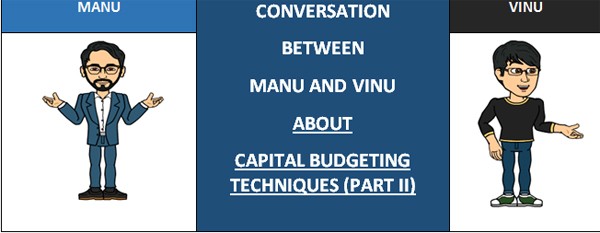This part covers Pay Back Period and touches on Time Value of Money
This is a second part of earlier article “Analysis on Capital Budgeting Techniques”. Start reading this Part II article only after reading the Part I article available in the following link:
Analysis on capital budgeting techniques

Section 6
Manu explains Pay Back Period concept and also clears why mere cash flows are not sufficient for Investment Decision Making:Section 6:
|
Manu |
Now tell me, what do you infer from those 8 Years cash flows? |
||||||||||||||||||||||||
|
Vinu |
Manu! The cash flows for 8 year
Aggregates to Rs.409.40 Crs whereas initial investment is only Rs.100 Crs. Its hell a lot of money! |
||||||||||||||||||||||||
|
Manu |
May be Yes! But don’t look at values grossly. You need to understand the nuance of Present value of Future cash flows. But before that, can you tell me how long this project takes to pay back or say recover the original investment of Rs.100 Crs. |
||||||||||||||||||||||||
|
Vinu |
Hmmm.... First Year - Rs.38.75 Crs Second Year – Rs.42.25 Crs Third year – Rs.45.05 Crs So cumulative cash flows up to year three Rs.126.05 Crs. |
||||||||||||||||||||||||
|
Manu |
It means, between year 2 & 3 you are recovering entire Rs.100 Crs. Can you find out exact period? |
||||||||||||||||||||||||
|
Vinu |
Recovery up to Year 2 is Rs.81 Crs [38.75 + 42.25] Amount to be recovered in Year 3 is Rs.19 Crs [100-81] for making up Rs.100 Crs. Whereas actual recovery in Year 3 is Rs.45.05 Crs. If Rs.45.05 Cr is earned in 12 months, then Rs.19 Crs can be earned in 5.06 months [19x 12/45.05] |
||||||||||||||||||||||||
|
Manu |
Exactly! By implementing this project, you can recover your investment of Rs.100 Crs in just 2 Years 5 months. |
||||||||||||||||||||||||
|
Vinu |
Wow! |
||||||||||||||||||||||||
|
Manu |
This is called Pay Back period of the project. This will play crucial role in Project Investments Decisions especially when you raise debts for shorter period. |
||||||||||||||||||||||||
|
Vinu |
Correct! If debt have to be repaid in shorter period, then the projects Payback period should also be short. |
||||||||||||||||||||||||
|
Manu |
Business entities would generally prefer projects with shorter payback period. If the payback is long, then risk associated with the projects is also more. Then return expectations from those projects will also be high. |
||||||||||||||||||||||||
|
Vinu |
True Manu! |
||||||||||||||||||||||||
|
Manu |
But this ‘Payback period’ alone as a tool to evaluate investment decision would become lopsided. |
||||||||||||||||||||||||
|
Vinu |
Why? |
||||||||||||||||||||||||
|
Manu |
If you are going to take a decision based only on the project which pays you back early, then you are ignoring the project which pays very well in the later years. You are ignoring the long term profitability of the business. |
||||||||||||||||||||||||
|
Vinu |
Very True! |
||||||||||||||||||||||||
|
Manu |
You are also ignoring the very important time value of money by placing reliance on payback period only. |
||||||||||||||||||||||||
|
Vinu |
What is that Time Value of Money? |
||||||||||||||||||||||||
|
Manu |
It is the fundamental concept in financial management. You cannot afford to be ignorant of that! |
||||||||||||||||||||||||
|
Vinu |
Please Manu! Throw light on that! |
||||||||||||||||||||||||
|
Manu |
The money which you get now is not equal to money which you will get in future. |
||||||||||||||||||||||||
|
Vinu |
Little more please! |
||||||||||||||||||||||||
|
Manu |
If I offer you Rs.1,000/- now and Rs.1,000/- a year after, which one would you prefer? |
||||||||||||||||||||||||
|
Vinu |
Both are one and the same! Both are same Rs.1000. I don’t find any different between the two! |
||||||||||||||||||||||||
|
Manu |
No! There are differences! |
||||||||||||||||||||||||
|
Vinu |
Difference? |
||||||||||||||||||||||||
|
Manu |
If I give you Rs.1000/- now, you can either consume or invest. Which one would you prefer? Consume or Invest? |
||||||||||||||||||||||||
|
Vinu |
It depends. If I have immediate requirement, I will consume. If not, I will Invest. |
||||||||||||||||||||||||
|
Manu |
Let’s say you invest in Deposit for 10% for one year. |
||||||||||||||||||||||||
|
Vinu |
So after one year, I will have Rs.1000 + Rs.100 Interest. |
||||||||||||||||||||||||
|
Manu |
Correct! Your present Rs.1000 is equal to Rs.1100 one year later. So, if I offer you either Rs.1000 now (or) One year after the same Rs.1000, you should automatically prefer now, because you can make it as Rs.1100. after one year by investing. Instead, if you are accepting my offer of Rs.1000 after one year, you are losing Rs.100. |
||||||||||||||||||||||||
|
Vinu |
Very True! Future value of Rs.1000 now for one year is Rs.1100. So I should accept only if you offer Rs.1100 after one year. |
||||||||||||||||||||||||
|
Manu |
You got that right. Future value of Rs.1000 now is Rs.1100. Or I would say present value of Rs.1100 received after one year is Rs.1000. Does that make sense? |
||||||||||||||||||||||||
|
Vinu |
Yes very much! |
||||||||||||||||||||||||
|
Manu |
Ok! Before we get back to our example, let us do a small calculation. Let’s say, you invest Rs.1000 and you get 10% interest every year on compounding, (meaning interest get accumulated) for a period of 5 years. In that case, what will be the future value of the investment? Please work out its computation. |
||||||||||||||||||||||||
|
Vinu |
Ok!
Is it correct? |
||||||||||||||||||||||||
|
Manu |
Ya! This table shows, -if you invest Rs.1000 in the beginning of the year, its future value at end of year 1 is Rs.1100/-. It means, if you are getting Rs.1100 at end of year 1, it is possible only if you invest Rs.1000 now! If you are getting Rs.1210 at the end of year 2, it is possible only if you invest Rs.1000/- now! Similarly, if you are getting Rs.1610/- at the end of year 5, it is possible only if you invest Rs.1000/- |
||||||||||||||||||||||||
|
Vinu |
True! |
||||||||||||||||||||||||
|
Manu |
So, we can say, the present value of Rs.1610/- to be received at the end of 5 years is Rs.1000/- |
||||||||||||||||||||||||
|
Vinu |
Yes! |
||||||||||||||||||||||||
|
Manu |
So this tells you, don’t get carried away by big numbers which you are going to get in future. You have to find its present value to take some meaning full decision. |
||||||||||||||||||||||||
|
Vinu |
But Manu, still I am not clear. How it is going to help investment decision by finding the Present Value of Future Cash Flows? |
||||||||||||||||||||||||
|
Manu |
It would help you Vinu! Let’s continue with our present case itself. Rs.1000 has been invested @ 10% for 5 years, right? |
||||||||||||||||||||||||
|
Vinu |
Yes! |
||||||||||||||||||||||||
|
Manu |
So by now you know, this Rs.1000 will become Rs.1610/- at the end of 5 Years. |
||||||||||||||||||||||||
|
Vinu |
Yes! |
||||||||||||||||||||||||
|
Manu |
So, if this Rs.1000/- becomes Rs.1610/- in 5 years, it means it means it has earned 10% every year without fail. Am I right? |
||||||||||||||||||||||||
|
Vinu |
Yes! |
||||||||||||||||||||||||
|
Manu |
And, only if it earns Rs.1610/- its present value would be equivalent to Rs.1000/- Is that correct? |
||||||||||||||||||||||||
|
Vinu |
Yes! Very much! |
||||||||||||||||||||||||
|
Manu |
What would be present value if amount received at the end of 5 years is Rs.1200/- instead of Rs.1610/- ? Will it be equivalent to Rs.1000/- |
||||||||||||||||||||||||
|
Vinu |
No! Because we know, @ 10% interest rate, present value of Rs.1610/- received after 5 years can be Rs.1000/- only. So it cannot be equivalent to Rs.1,000/- it should be obviously less than Rs.1,000/- |
||||||||||||||||||||||||
|
Manu |
Yes! That’s the point! Now this information would help you to take decision. |
||||||||||||||||||||||||
|
Vinu |
How? |
||||||||||||||||||||||||
|
Manu |
Let’s see. You are investing Rs.1000 @ 10% for 5 years. You have two options. Option 1 will give Rs.1610 at the end of 5 years. Option 2 will give Rs.1200 at the end of 5 years Which option you will select? |
||||||||||||||||||||||||
|
Vinu |
Obviously option 1. |
||||||||||||||||||||||||
|
Manu |
Yes! You should because, the present value of Rs.1610 is Rs.1000. In that case, it is equivalent to you give Rs.1000 and take back Rs.1000 now. But in option 2, the present value of Rs.1200 would be less than Rs.1000. It means, you are investing Rs.1000 now and taking back less than Rs.1000/- simultaneously. So you should not think of option 2. |
||||||||||||||||||||||||
|
Vinu |
True! |
||||||||||||||||||||||||
|
Manu |
I’ll also give you third option. Option 3 – You will get Rs.1800/- at the end of year 5. Which option you will prefer? |
||||||||||||||||||||||||
|
Vinu |
Now I would prefer option 3 because present value Rs.1800/- received at the end of 5 years would be more than Rs.1,000/- It would mean, I invest Rs.1000 now and take back more than Rs.1000 simultaneously. |
||||||||||||||||||||||||
|
Manu |
Yes! You got the crux of it. Any investment proposal should be viewed from this angle. You should find present value (PV) of future cash flows from project. If the PV of future cash flows are equal to Initial investment or Total Investment, then the investment is earning expected returns. If PV of future cash flows are greater than the Initial investment or Total Investment, it earns expected + extra. i.e., it earns more than your expected returns. |
||||||||||||||||||||||||
|
Vinu |
And if PV of future cash flows are less than the Initial investment or Total Investment, it earns less than our expectation. |
||||||||||||||||||||||||
|
Manu |
Hit on the Nail! To put it with some numbers, if you are expecting 10% returns and the project is going to earn 5%, you should be avoiding those projects. |
||||||||||||||||||||||||
|
Vinu |
Now I understand the Time value concept Manu! Let us proceed back with our example. |
Part III will be continued next week….
Author:
CA N Raja, B.Com.,PGDBA, ACA
Chartered Accountant
nrajca@gmail.com
www.concells.in/elearning







 CAclubindia
CAclubindia
